BabelStone Blog
Saturday, 12 July 2008
Playing Go on a Chinese Chess Board
Despite the large number of Song (960-1279) and Yuan (1271-1368) dynasty Chinese Chess pieces that have been discovered, there are few early depictions of Chinese Chess (Xiangqi 象棋) being played, and I do not know of any examples of Chinese Chess boards predating the Ming dynasty (1368-1644). One of the few examples of a Yuan dynasty painting relating to Chinese Chess is this mural, believed to have been painted in about 1319-1324, at the Lower Guangsheng Temple in Hongdong county of Shanxi province (in northern China, in an area that was previously under the rule of Jin regime, and close to the eastern border of the Western Xia regime and near the southern border of the Liao regime) :
Yuan Dynasty Mural at the Lower Guangsheng Temple
山西省洪洞縣廣勝寺水神廟明應王殿壁畫
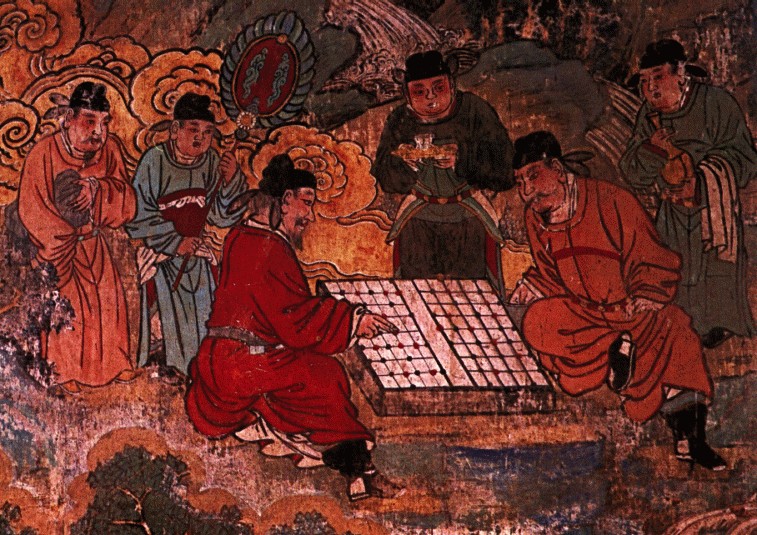
Source : Zhongguo Meishu Quanji 中國美術全集 (繪畫編) vol.13 plate 83
This is a wonderful picture, which as far as I can tell is rarely mentioned, and deserves far more attention than it has hitherto received. At first glance it appears to depict a game of Chinese Chess, with the broad river separating the two sides of the board, upon which are arrayed the black and red forces (Chinese Chess pieces typically being coloured black and red). But on closer inspection we find that all is not what it seems. Firstly, the board is not quite the right dimensions, being a grid of 9 x 12 lines rather than the expected 9 x 10 lines of the standard Chinese Chess board. Then when we look at the players, we see that the player on the left is about to place a piece onto the board, holding it with his middle finger and forefinger in the traditional way that Go stones are held; and at the same time the player on the right seems to be dipping his right hand into a bowl to get the next piece to play. And sure enough if you look closely at the board it is obvious that the black and red marks on the intersections of the board grid are not Chinese Chess pieces but Go stones :
Game Diagram for a Game of Go on a 9x12 Chinese Chess Board
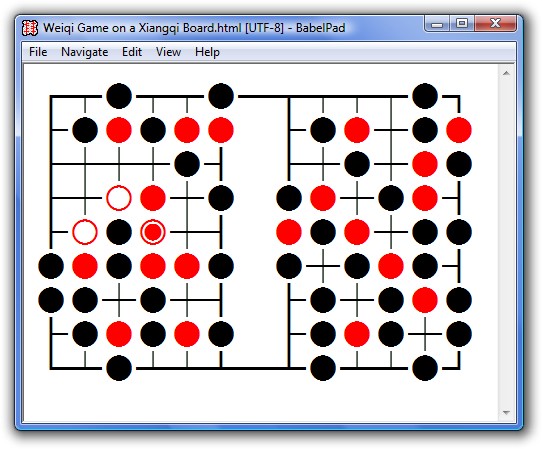
This must surely be the one and only record ever of a game of Go (Weiqi 圍棋) played on a 9 x 12 grid. What is fascinating about the picture is that the pieces have not been randomly dotted about the board by the artist, but do seem to represent a real game at one particular moment in time. With 38 black stones visible but only 20 red stones, it is clear that the red player (on the left) is not doing so well. It looks to me as if black has just played the ko in the middle of the right side of the board, and red is playing a ko threat, in which case I can only assume that his hand is obscuring two red stones (marked as hollow red circles in the diagram above), so that the stone he is putting down (marked as a red fish-eye in the diagram) threatens the entire bottom left corner.
There are perhaps several other points of interest in this game from a Go perspective, not least the use of black and red stones rather than the traditional black and white stones, but from the perspective of Chinese Chess the main interest is obviously the board. Given that the artist seems to have faithfully represented the exact layout of a game of Go in progress, we can hardly assume that the two extra gridlines are artistic error, and so it would seem that the board must have been as it is drawn. As the dividing river across the centre of the board is a feature exclusive to Chinese Chess, I think that the most likely explanation is that this board was intended for playing a lost variant form of Chinese Chess (when not being borrowed by some pretty desperate Go-players) which would have had a greater number of pieces than standard Chinese Chess (something more closely related to Japanese Shōgi 将棋 perhaps). The other interesting feature is the simple fact that substantial wooden Chinese Chess boards were in use, and that the game was not just played on ephemeral paper boards as it normally is nowadays. So perhaps one day an actual example of one of these unusual Chinese Chess boards will be unearthed.
Addendum [2008-07-14]
For comparison with the above game diagram, here is my best attempt at a game diagram for the game of Go depicted in the famous Tang dynasty (618-907) silk painting that was excavated from Tomb #187 at Astana in Xinjiang (in the nearby Tomb #206 both a 19 x 19 Go board and a Backgammon board were recovered).
Tang Dynasty Silk painting of a Go player
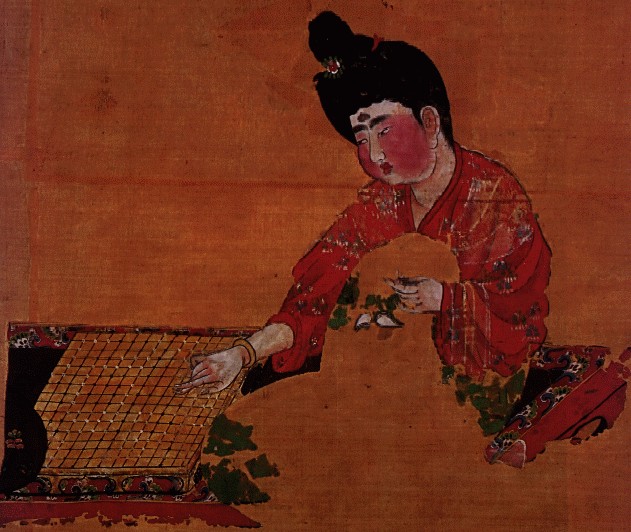
Source : Zhongguo Meishu Quanji 中國美術全集 (繪畫編) vol.2 plate 9
The stones are not very clearly marked in all cases, so it is only an approximation of what the artist actually painted, but nevertheless it is obviously not an acurate representation of a real game. Note also that the board has been painted as a 16 x 17 grid, which is almost certainly an error for a 17 x 17 grid.
Game Diagram for Tang Dynasty Silk Painting
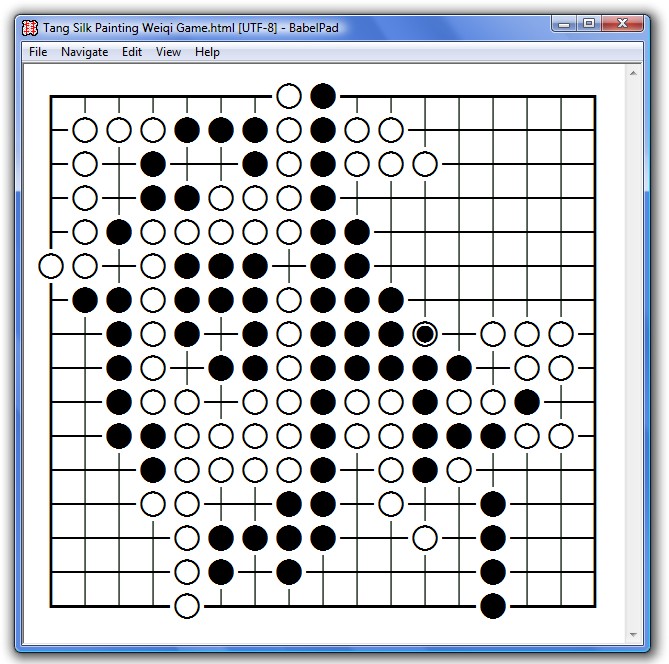
I have also found a game diagram for a 13 x 13 grid Go board (40 x 40 cm in size, with a 30 x 30 cm playing area) that was discovered in 1977 in a Liao dynasty (907-1125) tomb from Aohan in Inner Mongolia (敖漢旗白塔子遼墓). When the tomb was excavated it was found that although the board had partially decomposed, 79 black stones and 76 white stones (155 in total, 14 short of the expected 169 stones for a 13 x 13 board) were still laid out on it. I have retranscribed the game diagram below (the 14 spaces in the bottom right corner are where the 14 missing stones should have been, and the other spaces are where some of the stones have been misplaced from their original positions on the board). In this case the stones do not represent a game position, but appear to have just been laid out on the board for display.
Game Diagram for a Go Board from a Liao Dynasty Tomb
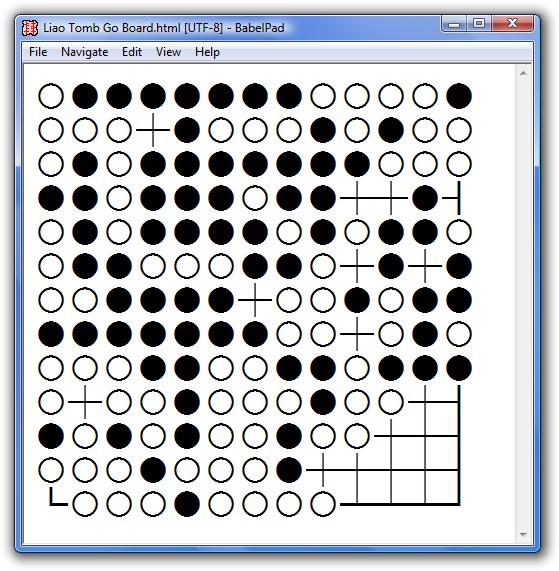
I don't have a picture of this Go board, but I do have a good picture of a game of Go on a mural from a different Liao dynasty tomb (at least I think it is a different tomb ... somewhere along the line I lost the source and description for this picture). It appears to show a Han Chinese player on the left and a Khitan nationality player on the right, with someone wearing an official's hat watching or adjudicating. It is difficult to be sure, but by my reckoning this is also a 13 x 13 board, which makes you wonder, did anyone in the peripheral areas of China play on a standard 19 x 19 board ?
Liao Dynasty Tomb Mural
(Click for a high resolution picture)
Index of BabelStone Blog Posts
